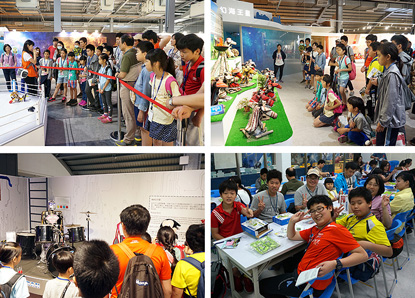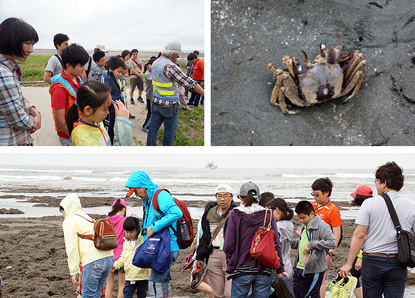Sketch of Archilife Study Tour, May 2017Date: 2017-06-06
Section: Activity |  5月份見識之旅活動,於2017年5月6日由呂明澐小姐帶領22位祐生見習生及家長們,進行桃園未來科技體驗暨觀新藻礁生態保育之旅。活動開始之初,領隊呂明澐小姐提醒本次活動注意事項及觀察重點,先行建立見習生的背景知識。 5月份見識之旅活動,於2017年5月6日由呂明澐小姐帶領22位祐生見習生及家長們,進行桃園未來科技體驗暨觀新藻礁生態保育之旅。活動開始之初,領隊呂明澐小姐提醒本次活動注意事項及觀察重點,先行建立見習生的背景知識。
For the study tour of May 6, 2017, Ms. Lu Ming-yun led 22 ARF interns and their parents on a tour to Taoyuan to experience future technologies and learn about ecological conservation at Guanxin Algal Reef. At the start of the day's activities, team leader Ms. Lu Ming-yun reminded everyone about things to note and what to observe, and provided the interns some general background knowledge.
 本次上午行程參訪位於桃園市的祥儀機器人夢工廠。該廠是全球最大的直流微小馬達齒輪箱製造廠,近年來為配合桃園航空城啟動、推動智能化產業與機器人教育,而打造結合產業趨勢、教育文創、益智娛樂等特色的觀光工廠。行程一開始,由導覽人員介紹館外長廊上的彩繪牆,描述一台機器人從無到有至少經歷115道製作工序,從設計、組裝到完成須花費許多時間與精力。接著移至館內進行導覽,透過導覽人員說明及機器人表演示範,了解不同軸數及伺服機的運用,可創造出多種不同功能型態的機器人,不僅於工業物料運輸、展場服務導覽,亦能用於日常生活與居家照護。導覽完畢,見習生與家長們各自帶開與機器人互動,體驗導覽人員講述的功能及特色。體驗結束後,即進行恐龍機器人DIY活動,利用太陽能電池照光產生電力,帶動環環相扣的大小齒輪,使機器人運作,製作過程雖然繁瑣複雜,但完成後眾人皆成就感十足。 本次上午行程參訪位於桃園市的祥儀機器人夢工廠。該廠是全球最大的直流微小馬達齒輪箱製造廠,近年來為配合桃園航空城啟動、推動智能化產業與機器人教育,而打造結合產業趨勢、教育文創、益智娛樂等特色的觀光工廠。行程一開始,由導覽人員介紹館外長廊上的彩繪牆,描述一台機器人從無到有至少經歷115道製作工序,從設計、組裝到完成須花費許多時間與精力。接著移至館內進行導覽,透過導覽人員說明及機器人表演示範,了解不同軸數及伺服機的運用,可創造出多種不同功能型態的機器人,不僅於工業物料運輸、展場服務導覽,亦能用於日常生活與居家照護。導覽完畢,見習生與家長們各自帶開與機器人互動,體驗導覽人員講述的功能及特色。體驗結束後,即進行恐龍機器人DIY活動,利用太陽能電池照光產生電力,帶動環環相扣的大小齒輪,使機器人運作,製作過程雖然繁瑣複雜,但完成後眾人皆成就感十足。
The tour began with a visit to Sha Yangye Robot Wonderland in Taoyuan City. The factory is the world's largest manufacturer of micro DC geared motors. The tourism factory, which combines industrial trends, education, culture and creativity, and intellectual entertainment, has been built in step with the launch of the Taoyuan Aerotropolis, and the push for smart industry and STEAM education, in recent years. The tour guide started by introducing the mural along the corridor outside the factory. It depicts the 115 manufacturing steps required to create a robot, showing that tremendous time and energy is required from design, assembly to completion. Back indoors, the interns found out from the tour guide's explanation and robot demonstration that different types of functional robots may be created by varying the number of axis and servers. They are not only used in industrial transportation and as tour guides in exhibitions, they are also used in everyday living and home care. At the end of the tour, interns and their parents were given time to freely interact with the robots, and experience the functions and features described by the tour guide. Next, there was a dinosaur robot DIY activity. The process of making the solar-powered robot with different connecting gears was complex but everyone felt a great sense of achievement upon completing their robots.
 午餐後,乘車前往觀新藻礁生態系野生動物保護區,主要保護對象為河口藻礁海洋生態系及在此處棲息的野生動植物。本次由桃園市觀音區保生社區發展協會理事長廖經贈先生擔任導覽老師,他首先說明觀新藻礁分布的範圍,以及目前所遭受的污染破壞與保育困境,讓眾人體認到藻礁保育刻不容緩的重要性。隨後說明藻礁大多數係由無節珊瑚藻鈣化後經年累月形成的礁體,多孔洞的特性可做為水中生物的棲地,亦具有天然防波堤的生態功能,提供生物緩衝的空間,而得以孕育眾多的物種,並帶領見習生們觀察濕地生物藏身於孔隙中的真實樣貌與習性。期間,眾人親見沙蟹遭遇危險時,會奮力以雙螯迅速挖沙將身體埋入洞穴中,以躲避敵人。至此,本日活動已近尾聲,大家一起合照留念後各自返家,並期待於下次見識之旅再相見。 午餐後,乘車前往觀新藻礁生態系野生動物保護區,主要保護對象為河口藻礁海洋生態系及在此處棲息的野生動植物。本次由桃園市觀音區保生社區發展協會理事長廖經贈先生擔任導覽老師,他首先說明觀新藻礁分布的範圍,以及目前所遭受的污染破壞與保育困境,讓眾人體認到藻礁保育刻不容緩的重要性。隨後說明藻礁大多數係由無節珊瑚藻鈣化後經年累月形成的礁體,多孔洞的特性可做為水中生物的棲地,亦具有天然防波堤的生態功能,提供生物緩衝的空間,而得以孕育眾多的物種,並帶領見習生們觀察濕地生物藏身於孔隙中的真實樣貌與習性。期間,眾人親見沙蟹遭遇危險時,會奮力以雙螯迅速挖沙將身體埋入洞穴中,以躲避敵人。至此,本日活動已近尾聲,大家一起合照留念後各自返家,並期待於下次見識之旅再相見。
After lunch, the bus took everyone to the wildlife refuge in the Guanxin Algal Reef Ecosystem. The wildlife refuge provides protection for estuarine reef ecosystem and wild flora/fauna in the habitat. Mr. Liao Ching-tzen, chairman of Baosheng Community Development Association in Taoyuan City's Guanyin District, was the designated tour guide. He began by explaining the extent of the Guanxin Algal Reef, and the threat of pollution and destruction it faces, and the difficulties in conserving the reef, underscoring the urgency of reef conservation. Mr. Liao explained that most algal reefs are formed by the calcification of crustose coralline algae over a long period of time. Their porous structure provides a habitat for marine organisms, and they are natural breakwaters that buffer the habitat against strong waves, allowing many marine species to thrive. The interns were also able to observe the actual appearance and habits of wetland organisms hiding in their holes. In particular, everyone witnessed how a sand crab used its pincers to dig itself into a hole rapidly in order to evade its enemy. At that point, the day's activities came to an end, everyone took a photo together before going their separate ways and looked forward to the next study tour.
|
|